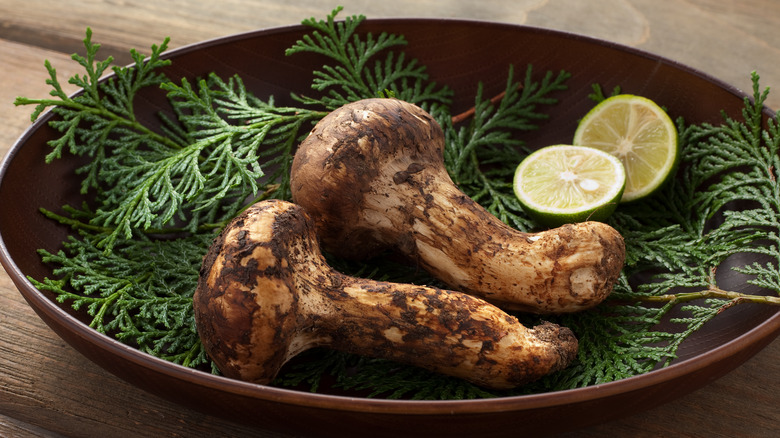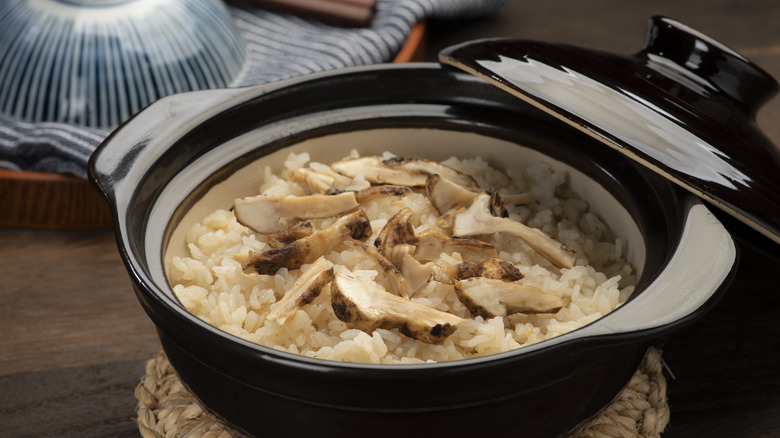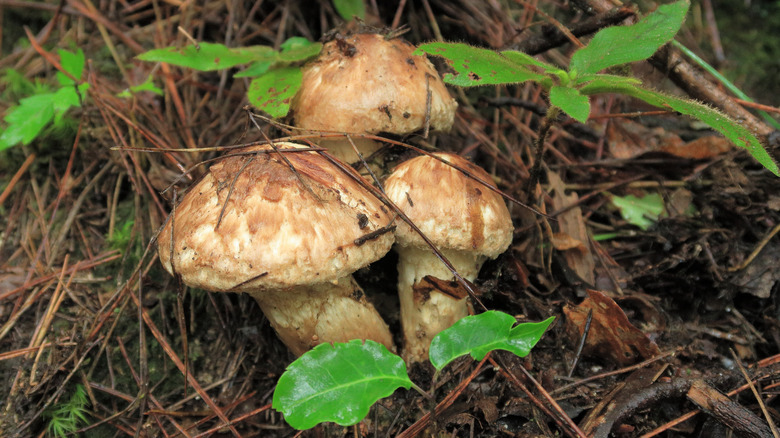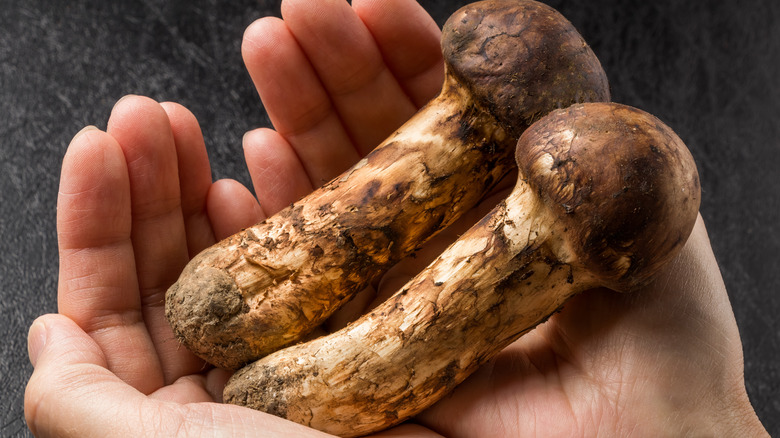The Rare Japanese Mushroom That Packs A Bold Flavor
In a cuisine rich in seasonal ingredients, matsutake mushrooms are a fall delicacy that are an exquisite, but fleeting, part of Japanese food culture. Scientifically known as tricholoma matsutake, matsutake mushrooms were eaten more than a millennium ago in the ancient capital city of Kyoto, and have been cited in poetry as far back as the 7th century — from which point the mushrooms have been known to be given as gifts throughout autumn. But, as the pine forests fade away, so do the matsutakes, and so do the cherished customs.
In the summer of 2020, matsutake mushrooms appeared on the IUCN list of threatened species for the first time. Deforestation, along with a disease caused by an invasive North American worm — the pinewood nematode that had been gradually spreading since the 1970s — caused a steep decline in red pine forests, the matsutake mushroom's natural habitat. This was especially evident in western Japan, where climate change has generated heat waves that only help to multiply the disease. Too rare to be cultivated like other mushrooms, matsutakes can go for anywhere from $40 a pound to $2,000.
Known for their meaty flesh, autumnal flavor, and earthy aroma comparable to truffles, the matsutake's rarity has only built its reputation into even more of a delicacy — one that experts from the IUCN recognize should be protected.
Cooking with matsutake mushrooms
Despite growing above the ground like a true mushroom — something truffles can't brag about — matsutakes have a pungent aroma that is often compared to the famous fungi. Their flesh are perfect for a plant-based meat alternative: thick, fibrous, and meaty; but are far more respected and used just as they are. Matsutake mushrooms are multi-dimensional, with flavors and aromas that range from notes of cinnamon, cedar, and pine to woodsy and spicy. Their unique flavor, rarity, and sheer price, make matsutakes best served as the starring role, because that's how you'll get the most of out them.
Whether steamed, sautéed, roasted, or in a broth, matsutake mushrooms have a delicate flavor that should be treated as such. Traditional Japanese dishes that use matsutake include matsutake gohan, a sought after rice dish that infuses the mushrooms with dashi, and sukiyaki, a Japanese style hot pot. However, since the decline of the red pine forests, Japan has had to begin importing more matsutakes from countries like China, South Korea, and Canada. But, just like wine, the different terroirs produce different flavors that matsutake aficionados may not appreciate.
No matter where your matsutake mushrooms come from, however, they should be treated like the stars they are. Keep it simple — and, by any means necessary, do not wash them underwater. Instead, follow Tasting Table's guide for the best way to clean mushrooms.
Where to buy matsutake mushrooms
Due to their rarity and short season, matsutake mushrooms can be difficult to hunt down — whether you're hoping to forage mushrooms from the wild yourself or buy them in store. Because they can't be cultivated like other mushrooms, this also means that they can get pretty pricey. Related species sell for around $40 a pound in the US, and up to $2,000 a pound for the highest quality matsutakes in Japan. There, matsutake mushrooms are considered a high status food, precious enough to give as a gift.
In the United States, there are two mushroom species related to the matsutake — tricholoma magnivelare and tricholoma murrillianum — that grow in the Pacific Northwest starting in the beginning of September. However, the USDA and National Forest Service have strict rules about who can pick them and where. In most places, you'll be required to carry a permit or letter of authorization to forage matsutake. The better bet may be to leave the foraging to the pros, and to look for them in stores while they're in season.
From September to November, you're most likely to find matsutake mushrooms in specialty grocery stores, farmers markets, and Asian supermarkets. They can also be purchased online from specialty mushroom foragers and growers. If you can't find them, you can also look for dried matsutake mushrooms. When dried, matsutakes actually have a much more intense flavor that is perfect for soups, stews, and vegetable-based broths.
Nutritional information
According to 2010 research published in the Journal of Medicinal Plant Research, matsutake mushrooms shouldn't only be savored for their rarity and bold flavor. As it turns out, these flavorful fungi are just a healthy as they are fancy. Matsutake mushrooms are actually made up of about 20% cell-repairing protein, which plays an important role in the growth and development of young people, pregnant women, and, of course, athletes — and also makes them a favorite vegetarian ingredient. But matsutake mushrooms also contain an impressive amount of fiber — a carbohydrate that only 5% of the population gets enough of, according to a 2017 study published in The National Library of Medicine.
Research also shows that matsutake mushrooms are a good source of minerals and essential amino acids — the major one being methionine, one of the nine essential amino acids your body needs to function properly. But they're also rich in glutamic acid, another amino acid that plays an active role in your body's metabolism, nervous system, brain function, and the detoxification of your liver. As far as minerals go, matsutake mushrooms contain important B vitamins, copper, potassium, zinc, and selenium, which all contribute to your overall health and well being.
Being low in saturated and unsaturated fat, it's safe to say matsutake mushrooms are just as healthy, and tasty, as their price tag suggests.



